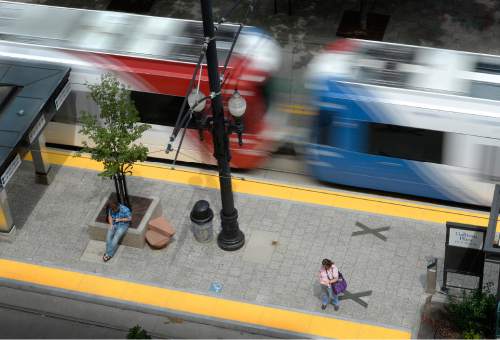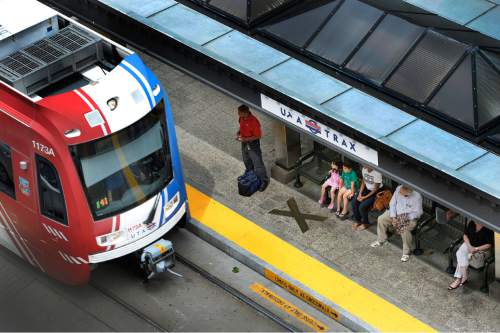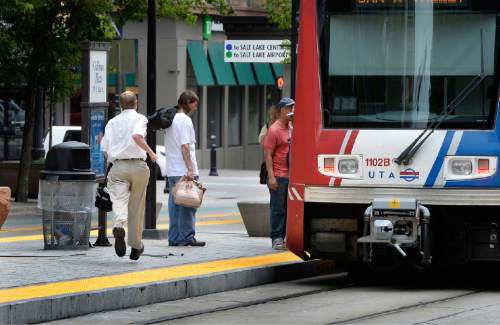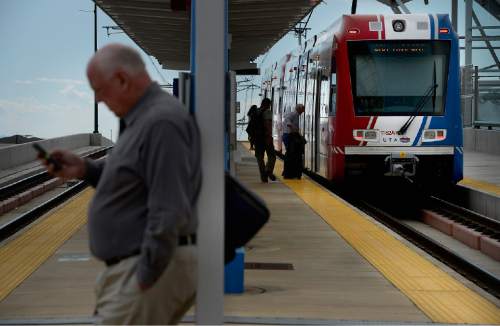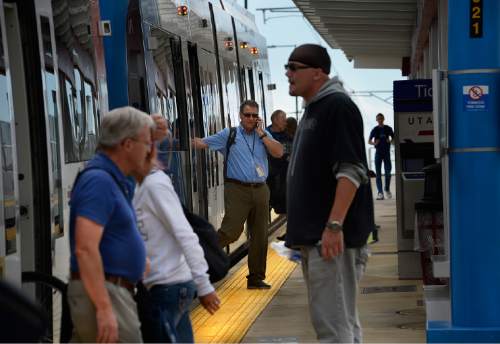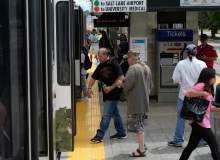This is an archived article that was published on sltrib.com in 2015, and information in the article may be outdated. It is provided only for personal research purposes and may not be reprinted.
After investing more than $2.5 billion in recent years to expand FrontRunner, TRAX and the Sugar House Streetcar, guess how many Salt Lake City metro-area workers now commute by mass transit?
Only 3.4 percent, according to the 2013 American Community Survey by the U.S. Census. In the Ogden-Clearfield metro area, it is 2.2 percent. In Provo-Orem, it is 2 percent. The average nationally is higher: 5 percent.
However, a couple of small areas in Salt Lake actually do achieve high transit ridership — and the Utah Transit Authority said reasons behind those successes provide a possible road map on how to increase ridership throughout the Wasatch Front.
For example, 37 percent of University of Utah students, staff and faculty take UTA trains and buses every day, according to a university survey of commuters.
In addition, 25 percent of commuters to Salt Lake City's central business district use transit, according to estimates by InterPlan Transportation Planning, a UTA contractor that studied the effects of the agency's recent expansion of rail lines.
Those two areas enjoy higher ridership because regional transit networks were designed to target them as destinations, and both have major employers that offer extensive free or discounted UTA pass programs.
"Where we make these major investments, [transit] becomes more important," said Hal Johnson, UTA manager of integrated-project development. He added that plans are in the works to replicate such efforts elsewhere — including in Ogden, Utah County, a Murray-Taylorsville corridor, Sandy and South Jordan.
UTA spokesman Remi Barron said the agency suspects the share of commuters using UTA may already be higher than the 3.4 percent shown for the Salt Lake metro area by the most recent Census estimates in 2013. He noted some extensions of TRAX and FrontRunner were completed since then and may have boosted numbers.
—
Freeway benefits • High ridership to the U. and downtown have benefited all commuters, Johnson said, by helping transit carry the equivalent of 1.5 freeway lanes full of people each day between 6400 South and downtown Salt Lake City, making Interstate 15 less congested.
A freeway lane can carry about 2,000 vehicles an hour, and Utah Department of Transportation data show cars on the freeway in that stretch average 1.1 riders each. Johnson said UTA systems carry about 3,000 people an hour in segments between Murray and downtown Salt Lake City.
"We're trying to help smooth the flow of traffic on the freeway system," Johnson said. "So that's where transit plays a big role, and that's one reason why we've made these investments in commuter rail and light rail."
—
U. did it • Johnson said the story of what happened at the U. is instructive about what can happen elsewhere over time.
He said about 3 percent of students and staff rode transit until the school offered passes to help solve chronic parking problems — and then it jumped to about 10 percent.
"Then we implemented the first TRAX line on campus. It was a game changer, and we went to about 25 percent," he said. "Then we added the second TRAX line up through the medical center, and it increased ridership more."
Johnson said officials saw something interesting the first few years that TRAX was on campus.
"Ridership kept increasing because old students would graduate out who were used to driving, and new students were coming in that were riding transit," he said. "That's what built up to this 37 percent" who currently use transit to commute.
A U. study last year also found that "since the University TRAX line opened, there has been increased development in the 400/500 South corridor, yet traffic on the street has actually declined," professor Reid Ewing said in an interview last year.
"Our calculations show that without the University TRAX line, there would be at least 9,300 more cars per day on 400/500 South, and possibly as many as 21,700 additional cars," Ewing said. "The line avoids gridlock, as well as saves an additional 13 tons of toxic air pollutants" a year.
—
Destination downtown • Meanwhile, studies said that in Salt Lake City's central business district — between about South Temple and 400 South, and 200 East to 400 West — 3 percent of commuters used transit in 2000.
But it has grown to 25 percent as rail systems were completed that deliver people there, and large employers such as the LDS Church and state government offered passes for workers.
UTA-sponsored studies show that the percentage is higher for downtown commuters from certain areas:
• An estimated 35 percent of all Sandy-to-downtown commuters use transit because of easy connections on TRAX.
• About 30 percent of commuters from South Jordan/West Jordan to downtown take TRAX, thanks to the recent red-line route in that area and also extension of FrontRunner through the area.
• Some 29 percent of commuters from West Valley City and Taylorsville to downtown take transit, due in part to the TRAX green line into West Valley City.
—
Next targets • Johnson said UTA is working to stretch its regional networks in ways that could replicate the high ridership to the U. and downtown.
For example, it is studying upgrading a transit corridor in Ogden to better connect its intermodal hub to downtown, Weber State University and McKay-Dee Hospital.
"It's a similar market to the University of Utah," he said.
Johnson noted construction is being planned for a bus-rapid-transit line — sort of a TRAX on rubber wheels, where buses have dedicated lanes and sell tickets through machines — connecting a FrontRunner station in Orem to Utah Valley University, Orem's University Mall, Brigham Young University, downtown Provo and Provo's Towne Centre mall.
"It's kind of the perfect linking of those destinations" that could boost ridership, he said.
Johnson added that UTA is working on a bus-rapid- transit line to connect the Murray FrontRunner and TRAX stations to Salt Lake Community College in Taylorsville and the Valley Fair Mall in West Valley City. Along with new higher ridership attracted by the West Valley City TRAX line, he foresees the share of transit growing there as well.
UTA is completing a study looking at how to better link areas of South Jordan and Sandy with transit between a South Jordan FrontRunner station and TRAX station in Sandy. Cities there are interested in planning redevelopment around transit.
"We try to target those areas where people will use it the most," Johnson said.
"The more we extend the regional system, the more destinations we connect, the more options we have, then the more [people] will use the regional system because it goes more places that work for them."
ldavidson@sltrib.com Twitter: @LeeHDavidson


